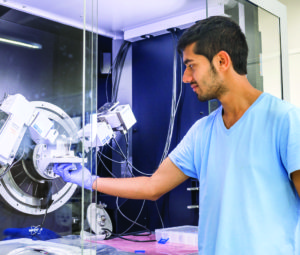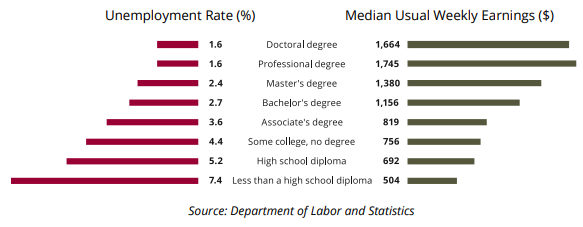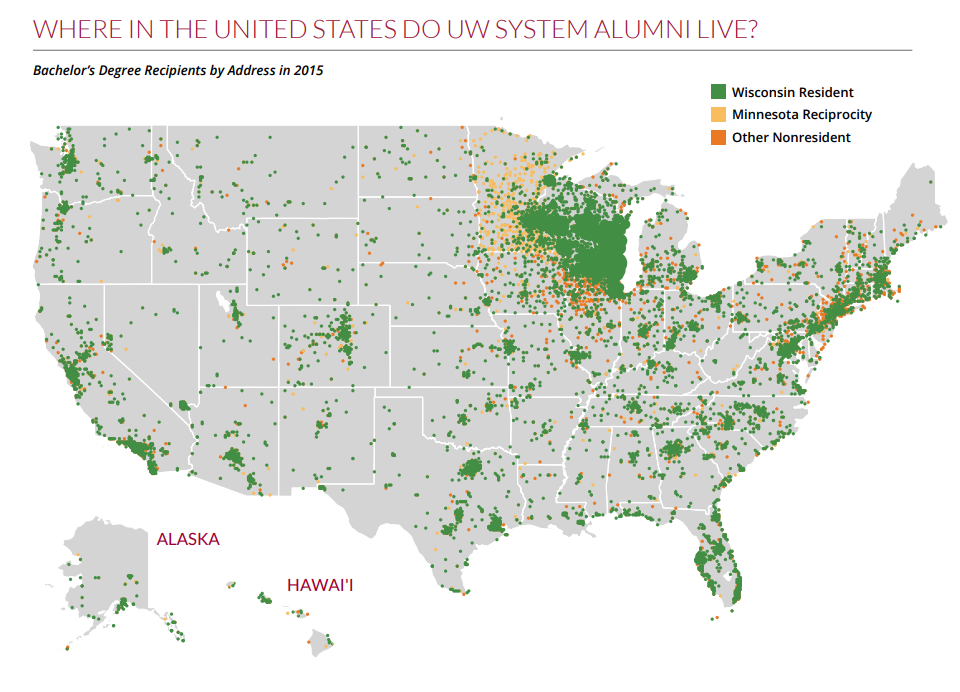Economic Impact Study 2018
UW System Economic Impact: Beyond the Traditional Numbers
 The scope of this study is limited to updating the 2002 UW System economic impact study and reporting the economic impact of UW System campuses, related organizations and activity, startups, and other major contributors. As reported earlier, that economic impact is over $24 billion annually based upon data from fiscal year 2016-17.
The scope of this study is limited to updating the 2002 UW System economic impact study and reporting the economic impact of UW System campuses, related organizations and activity, startups, and other major contributors. As reported earlier, that economic impact is over $24 billion annually based upon data from fiscal year 2016-17.
However, the economic impacts not included within the scope of this study likely far outweigh those reported here, including:
- Wisconsin workforce/talent base
- Wisconsin tax base
- Wisconsin research and innovation
One year after graduation, 91% of UW System graduates live in Wisconsin.
Wisconsin Workforce and Talent Base
In 2016-17, UW System campuses conferred a total of 27,459 bachelor’s degrees. Surveys from prior-year graduating classes indicate that a very high percentage of recent graduates stay and work in Wisconsin. For example, 91% of 2013-14 bachelor’s degree recipients lived in Wisconsin one year after graduation. This stream of college graduates adds to the talent base of Wisconsin’s workforce and provides skilled employees for Wisconsin businesses (see map).
Additional data also show that UW System graduates with bachelor’s degrees are filling key shortages in health care, science, and engineering fields. In 2016-17, there were 9,716 science, technology, engineering, and math (STEM) graduates and 3,460 health care graduates.
Wisconsin Tax Base
UW System graduates add to the earning power and tax base of the State of Wisconsin. Data shows college graduates earn approximately $1 million more than high school graduates over their careers and have significantly lower unemployment. These higher earnings produce tax revenue for the state, counties, and other units of Wisconsin government through a variety of taxes, including income tax, sales tax, property tax, and more (see Figure 6).
Figure 6. Earnings and Unemployment by Educational Attainment
Wisconsin Research and Innovation
 The UW System is a major source of research and innovation. More than $1 billion of sponsored research activity occurs on UW System campuses each year. The output of much of that research benefits citizens and businesses in Wisconsin, as well as across the nation.
The UW System is a major source of research and innovation. More than $1 billion of sponsored research activity occurs on UW System campuses each year. The output of much of that research benefits citizens and businesses in Wisconsin, as well as across the nation.
Three affiliated UW System organizations are particularly important to innovation in the Wisconsin economy. The oldest and largest of these organizations is the Wisconsin Alumni Research Foundation (WARF).
Established in 1925, WARF facilitates the technology transfer needs of UW-Madison. From the discovery of Vitamin D to groundbreaking work with stem cells, WARF continues to convert UW-Madison research into commercial products or applications.
Of growing importance in the innovation space are the UW-Milwaukee Research Foundation (UWMRF) and the WiSys Technology Foundation (WiSys). Both foundations are approximately 20 years old and they serve the technology transfer needs of UW-Milwaukee and the UW System comprehensive universities. Both foundations are ranked in the top 130 technology transfer organizations in the United States.
Ideas that lead to new or better products and services come from UW System campuses around the state thanks to the support of these foundations.

